
Flamenco is an art form based on the various folkloric music traditions of southern Spain, developed within the gitano subculture of the region of Andalusia, and also having historical presence in Extremadura and Murcia. In a wider sense, the term is used to refer to a variety of both contemporary and traditional musical styles typical of southern Spain. Flamenco is closely associated to the gitanos of the Romani ethnicity who have contributed significantly to its origination and professionalization. However, its style is uniquely Andalusian and flamenco artists have historically included Spaniards of both gitano and non-gitano heritage.
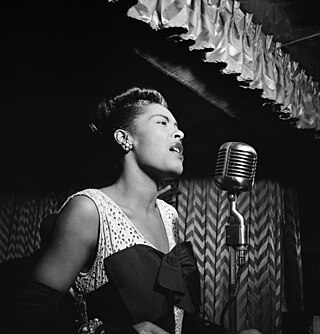
A song is a musical composition performed by the human voice. The voice often carries the melody using patterns of sound and silence. Songs have a structure to them, such as the common ABA form, and are usually made of sections that are repeated or performed with variation later. A song without instruments is said to be a cappella.
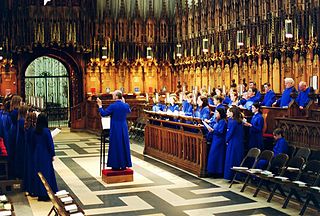
A choir is a musical ensemble of singers. Choral music, in turn, is the music written specifically for such an ensemble to perform or in other words is the music performed by the ensemble. Choirs may perform music from the classical music repertoire, which spans from the medieval era to the present, or popular music repertoire. Most choirs are led by a conductor, who leads the performances with arm, hand, and facial gestures.
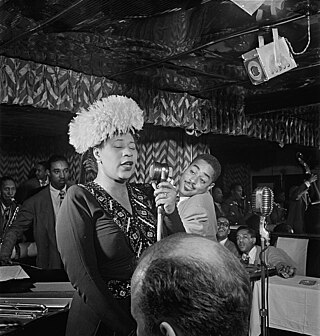
Originating in vocal jazz, scat singing or scatting is vocal improvisation with wordless vocables, nonsense syllables or without words at all. In scat singing, the singer improvises melodies and rhythms using the voice solely as an instrument rather than a speaking medium. This is different from vocalese, which uses recognizable lyrics that are sung to pre-existing instrumental solos.

A jazz band is a musical ensemble that plays jazz music. Jazz bands vary in the quantity of its members and the style of jazz that they play but it is common to find a jazz band made up of a rhythm section and a horn section.

Overtone singing, also known as overtone chanting, harmonic singing, polyphonic overtone singing, or diphonic singing, is a set of singing techniques in which the vocalist manipulates the resonances of the vocal tract to arouse the perception of additional separate notes beyond the fundamental frequency that is being produced.
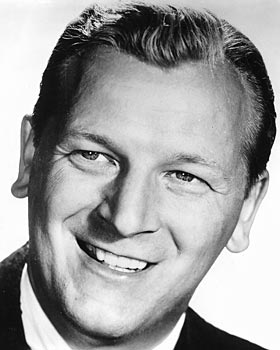
Leslie Thompson Baxter was an American musician, composer and conductor. After working as an arranger and composer for swing bands, he developed his own style of easy listening music, known as exotica and scored over 250 radio, television and motion pictures numbers.

Accompaniment is the musical part which provides the rhythmic and/or harmonic support for the melody or main themes of a song or instrumental piece. There are many different styles and types of accompaniment in different genres and styles of music. In homophonic music, the main accompaniment approach used in popular music, a clear vocal melody is supported by subordinate chords. In popular music and traditional music, the accompaniment parts typically provide the "beat" for the music and outline the chord progression of the song or instrumental piece.
Georgia has rich and still vibrant traditional music, primarily known for arguably the earliest polyphonic tradition of the Christian world. Situated on the border of Europe and Asia, Georgia is also the home of a variety of urban singing styles with a mixture of native polyphony, Middle Eastern monophony and late European harmonic languages. Georgian performers are well represented in the world's leading opera troupes and concert stages.

Beatboxing is a form of vocal percussion primarily involving the art of mimicking drum machines, using one's mouth, lips, tongue, and voice. It may also involve vocal imitation of turntablism, and other musical instruments. Beatboxing today is connected with hip-hop culture, often referred to as "the fifth element" of hip-hop, although it is not limited to hip-hop music. The term "beatboxing" is sometimes used to refer to vocal percussion in general.
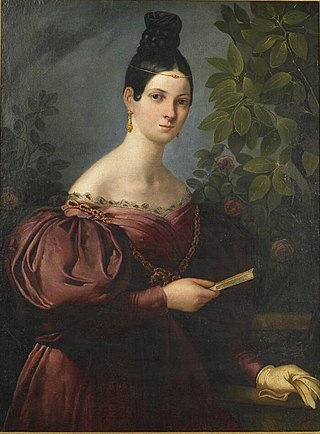
Maria Felicia Malibran was a Spanish singer who commonly sang both contralto and soprano parts, and was one of the best-known opera singers of the 19th century. Malibran was known for her stormy personality and dramatic intensity, becoming a legendary figure after her death in Manchester, England, at age 28. Contemporary accounts of her voice describe its range, power and flexibility as extraordinary.

The lead vocalist in popular music is typically the member of a group or band whose voice is the most prominent melody in a performance where multiple voices may be heard. The lead singer sets their voice against the accompaniment parts of the ensemble as the dominant sound. In vocal group performances, notably in soul and gospel music, and early rock and roll, the lead singer takes the main vocal melody, with a chorus or harmony vocals provided by other band members as backing vocalists. Lead vocalists typically incorporate some movement or gestures into their performance, and some may participate in dance routines during the show, particularly in pop music. Some lead vocalists also play an instrument during the show, either in an accompaniment role, or playing a lead instrument/instrumental solo role when they are not singing.

Zoila Augusta Emperatriz Chávarri del Castillo, known as Yma Sumac, was a Peruvian-born vocalist, composer, producer, actress and model. She won a Guinness World Record for the Greatest Range of Musical Value in 1956. "Ima sumaq" means "how beautiful" in Quechua. She has also been called Queen of Exotica and is considered a pioneer of world music. Her debut album, Voice of the Xtabay (1950), peaked at number one in the Billboard 200, selling a million of copies in the United States, and its single, "Virgin of the Sun God ", reached number one on the UK Singles Chart, becoming an international success in the 1950s. Albums like Legend of the Sun Virgin (1952), Fuego del Ande (1959) and Mambo! (1955), were other successes.
Vocal jazz or jazz singing is a genre within jazz music where the voice is used as an instrument.

A vocal warm-up is a series of exercises meant to prepare the voice for singing, acting, or other use.
Malagueñas is one of the traditional styles of Andalusian music (flamenco), derived from earlier types of fandango from the area of Málaga, classified among the Cantes de Levante. Originally a folk-song type, it became a flamenco style in the 19th century. It is not normally used for dance, as it is generally interpreted with no regular rhythmic pattern, as a "cante libre". It has a very rich melody with virtuous flourishes and use of microtones. Its guitar accompaniment is normally played in open position first inversion giving E for the tonic, which can be transposed by using a capo.
In the years centering on 1600 in Europe, several distinct shifts emerged in ways of thinking about the purposes, writing and performance of music. Partly these changes were revolutionary, deliberately instigated by a group of intellectuals in Florence known as the Florentine Camerata, and partly they were evolutionary, in that precursors of the new Baroque style can be found far back in the Renaissance, and the changes merely built on extant forms and practices. The transitions emanated from the cultural centers of Northern Italy, then spread to Rome, France, Germany, and Spain, and lastly reached England . In terms of instrumental music, shifts in four discrete areas can be observed: idiomatic writing, texture, instrument use, and orchestration.
Non-lexical vocables, which may be mixed with meaningful text, are a form of nonsense syllable used in a wide variety of music. Common English examples are "la la la", "na na na" and "da da da".
Vocalists are capable of producing a variety of extended technique sounds. These alternative singing techniques have been used extensively in the 20th century, especially in art song and opera. Particularly famous examples of extended vocal technique can be found in the music of Luciano Berio, John Cage, George Crumb, Peter Maxwell Davies, Hans Werner Henze, György Ligeti, Demetrio Stratos, Meredith Monk, Giacinto Scelsi, Arnold Schoenberg, Salvatore Sciarrino, Karlheinz Stockhausen, Tim Foust, Avi Kaplan, and Trevor Wishart.
Soprano sfogato is a contralto or mezzo-soprano who is capable — by sheer industry or natural talent — of extending her upper range and encompassing the coloratura soprano tessitura. An upwardly extended "natural" soprano is sometimes called soprano assoluto.













